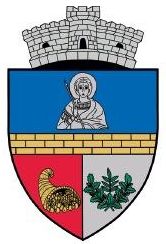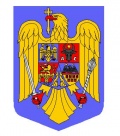Teregova: Difference between revisions
Knorrepoes (talk | contribs) m (Text replacement - "Literature : " to "'''Literature''': ") |
Knorrepoes (talk | contribs) m (Text replacement - "'''Literature'''" to "[https://www.heraldry-wiki.com/bibliography '''Literature''']:") |
||
| (4 intermediate revisions by the same user not shown) | |||
| Line 1: | Line 1: | ||
''' {{uc:{{PAGENAME}}}} ''' | ''' {{uc:{{PAGENAME}}}} ''' | ||
| Line 13: | Line 11: | ||
The arms were officially granted on October 7, 2014. | The arms were officially granted on October 7, 2014. | ||
The brick bar represents the Roman camp Ad Panonnios dating from the | The brick bar represents the Roman camp Ad Panonnios dating from the 15<sup>th</sup> century, which attests the antiquity of the settlement. | ||
The effigy of Saint Dumitru (the haloed bust) represents the Romanian-Orthodox place of worship dedicated to the Holy Great Martyr Dimitrie, a historical monument built between 1782-1784. | The effigy of Saint Dumitru (the haloed bust) represents the Romanian-Orthodox place of worship dedicated to the Holy Great Martyr Dimitrie, a historical monument built between 1782-1784. | ||
| Line 21: | Line 19: | ||
The mural crown with a crenellated tower means that the locality has the rank of commune. | The mural crown with a crenellated tower means that the locality has the rank of commune. | ||
{{ro}} | |||
{{media}} | {{media}} | ||
[ | [https://www.heraldry-wiki.com/bibliography '''Literature''']:: | ||
image from the decree 854/2014 | image from the decree 854/2014 | ||
Latest revision as of 10:31, 23 February 2025
TEREGOVA
District/county (județ) : Caraș-Severin
Official blazon
Un scut triunghiular cu marginile rotunjite, tăiat de un brâu zidit de aur și despicat în partea inferioară. În partea superioară, în câmp albastru, se află bustul unui personaj aureolat, văzut din față, îmbrăcat după moda bizantină, purtând o mantie legată pe umărul drept și ținând în mâna dreaptă o lance îndreptată cu vârful în sus, totul de argint. În partea inferioară, în dreapta, în câmp roșu, se află cornul abundenței cu prune, totul de aur. În partea inferioară, în stânga, în câmp argintiu, se află o frunză de frasin verde și două crengi de stejar cu frunze verzi și ghinde maro. Scutul este timbrat de o coroană murală de argint cu un turn crenelat.
Origin/meaning
The arms were officially granted on October 7, 2014.
The brick bar represents the Roman camp Ad Panonnios dating from the 15th century, which attests the antiquity of the settlement.
The effigy of Saint Dumitru (the haloed bust) represents the Romanian-Orthodox place of worship dedicated to the Holy Great Martyr Dimitrie, a historical monument built between 1782-1784.
The horn of plenty symbolizes one of the occupations of the inhabitants, fruit growing. The ash leaf and oak branches symbolize the forest richness of the locality.
The mural crown with a crenellated tower means that the locality has the rank of commune.
Romania heraldry portal
This page is part of the Romania heraldry portal |
Heraldry of the World |
|
Civic heraldry:
|
Other heraldry: |
Contact and Support
Partners:
Your logo here ?
Contact us
© 1995-2025, Heraldry of the World, Ralf Hartemink 
Index of the site
Literature:: image from the decree 854/2014











